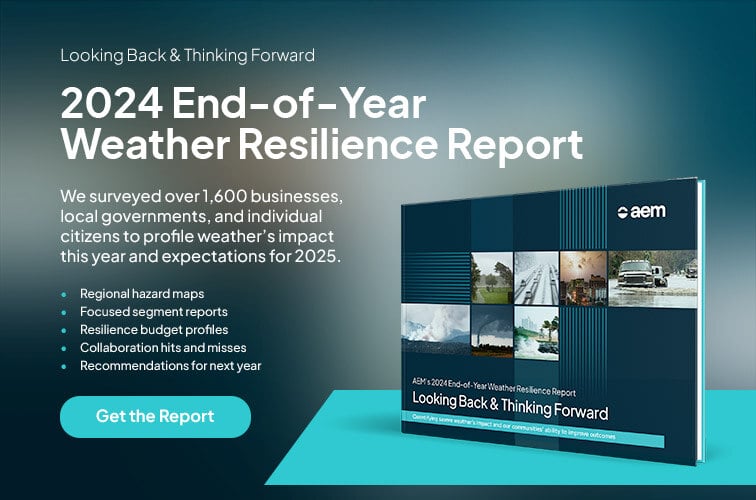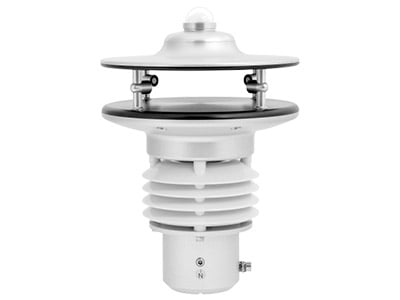
Measuring and analyzing the weather has always been relevant to scientists and farmers, but in recent years, understanding what's going on with the weather has become a greater area of concern around the globe. In order to address emerging weather challenges, we need devices that can capture data to inform our planning in a variety of settings and contexts. Moving forward, we'll explore...
- How to define "weather sensor"
- Why weather sensors are highly relevant right now
- What kind of people and businesses need weather sensors
- The main types of weather sensors, with examples from the AEM family of brands
- The information you need to know to choose the right weather sensor
What is a weather station sensor?
A sensor is a device that measures or observes a given factor with an eye towards reporting data for analysis and to inform decision making. Weather station sensors are environmental monitoring devices that measure or quantify weather data.
Sometimes, a single weather monitoring sensor can get the job done. (For example, if you only care about measuring temperature, you can achieve that with one sensor.) In most cases, however, a variety of sensors are configured into a weather station that can measure all the factors relevant to a given application.
Why invest in weather sensors?
Severe weather risk management is one of the great challenges of our time. The recent record-setting European summers, droughts across North America, and increasingly virulent wildfires are all clear evidence of that.
Weather sensors provide governments, businesses, and individuals with the data they need to stay prepared and respond as appropriate in the face of growing weather challenges.
Extreme weather preparedness
Major weather events like hurricanes and floods are growing in both frequency and intensity. Businesses and governments need to think more than ever about how severe weather might impact daily life and the continuity of their ability to deliver services.
Enhanced public and worker safety
Keeping people safe is the number one imperative for anybody in a leadership position, whether it's in the public or private sector. Weather sensors can help employers understand when it's safe or unsafe for different kinds of work to take place and assist municipalities in making decisions for the good of the community.
Minimize business disruption
If keeping people safe is the number one imperative for leaders, maintaining the flow of commerce to the highest degree possible is number two. While it's crucial to know when it's unsafe for workers to be in a given area or doing a given job, it's equally important that you can make hay while the sun shines -- and even when it doesn't but there's no dangerous lightning around.
Weather station sensors provide the data that leaders need to figure out the most advantageous time to start, stop, resume, or delay work, providing a balance of safety and continuity that simply isn't possible using a traditional broadcast forecast.
Who uses weather sensor technologies?
A wide variety of individuals, businesses, municipalities, and research organizations use different kinds of weather sensors to achieve their weather monitoring goals. Here are a few different examples of weather sensor applications:
Personal users
Weather enthusiasts often use personal weather station sensors to do things like:
- Conduct informal studies of weather at their home
- Make the most of gardening efforts
- Keep a weather journal
- Generate data to share with friends and family
Aviation
In the world of aviation, just about every aspect of business is weather-dependent. Planes can't take off or approach airports when strong storms are in the area. Airport roadways can become unsafe during severe weather events. Baggage handlers, mechanics, and marshals cannot work on the tarmac when lightning is striking nearby.
Airports and airlines both use weather sensor networks to maximize operational continuity while keeping workers and the public safe. Airports use their meteorological sensors to understand when weather could impact public safety and the flow of travelers through the airport. Airlines use their ground-level sensors to ensure they can communicate with employees as quickly as possible when weather that could affect their work is in the area.
Increasingly, major airports are using their sensors to provide weather data as a service to their resident airlines.
Agriculture
Throughout history, farmers have always wanted as much weather intel as they can get their hands on. That's because predicting and manifesting a strong harvest is directly dependent on sunshine, rainwater, and maximizing the use of fertilizer with strategic timing.
Farmers and agronomists were some of the earliest and most successful adopters of modern weather monitoring technology. In the 1980s, state universities in farm-belt states began creating mesonets , or weather sensor grids, to provide growers with the data they needed to farm smarter. Today, farmers continue to be at the frontlines of transforming data from weather sensors into decisions that have a positive real-world impact.
Schools
Education can't happen unless students are physically safe - that's just a fact. With that said, outdoor activities like sports, field trips, and on-campus events are key parts of the school experience. In order to provide the proper balance of fun and safety, schools need to keep a keen eye on the weather.
If you keep your eyes on the roofs and green spaces, you'll notice that weather sensors are an increasingly common sight at K-12 schools. That's because weather stations provide schools and districts with the information they need to make and justify calls about snow days, sports practices, and so on. Meteorological sensors at schools also create a foundation of authentic hyperlocal weather data that STEM teachers can use to engage students and teach them important environmental science and math concepts.
At the university level, where campuses operate like small cities, local weather sensor networks help school leaders understand when to cancel classes, structural strain on buildings, and more.
Sports Clubs & Sporting Events
Whether you're a professional or a rec leaguer, it's not safe to play sports during a thunderstorm. At the same time, cancelling events has a major cost, both in terms of lost revenue and community morale. That's why weather sensors play a key role at every level of sports, from local youth leagues to Major League Baseball.
Weather monitoring is what helps teams and clubs get those calls right in a way that protects both people and business. For town parks, that could look like a single weather station. At a professional-grade stadium, a network of strategically placed stations can be used to create a full picture view of real-time conditions.
Maritime
There are few situations where you're at the mercy of the weather quite like being out at sea. In fact, our Davis Instruments brand started as a maritime supply company, and LAMBRECHT meteo is currently recognized as an international leader in the space.
Sailors, especially at a high level, need as much information as possible about wind speed and direction in order to optimize their routes and make the most of their sails. On larger vessels, like cargo ships, tankers, or cruise ships, accurate weather information is key to ensuring the ship stays on a safe course. Since boats are often hundreds of miles away from the nearest local weather report, it's crucial they have onboard meteorological sensors they can rely on.
Utility Companies
Utility companies are responsible for maintaining a tremendous amount of physical infrastructure - think of power plants, high-tension towers, hydroelectric dams, and generation windmills. All of those are large structures that must stand up to the wind, precipitation, and extreme temperatures year-round. Given the power of electricity, they're also potentially massive fire hazards in the event of substantial damage from severe weather.
In order to provide service continuity for customers, utility companies operate private weather monitoring networks made up of meteorological sensors across their service area, somewhat similar to an agricultural mesonet. These sensors help utilities calculate how much power they'll need to generate based on the weather, when it's safe or unsafe for service crews to work, and how to respond in the case of a major weather event.
What are the main types of weather sensor?
Generally, weather sensors are categorized based on the environmental factors they measure. Let's take a look at some of the most common and useful types of meteorological measurement devices:
Multi-weather sensors
As their name implies, multi-weather sensors measure a variety of factors using a single unit. They're ideal for applications where a full-picture view of weather conditions is necessary and provide a simplified installation.
The LAMBRECHT meteo WS7 is an example of a high-precision multi-weather sensor that offers the power of an entire weather station in a package that's just 199mm x 284mm (about 8" x 11"). It can measure seven parameters simultaneously:
- Wind direction & speed
- Air temperature
- Relative humidity
- Barometric pressure
- Global radiation
- Dewpoint
Temperature, humidity, and pressure sensors
Temperature and humidity sensors are some of the most commonly used weather sensors. They can be used to calculate a heat index, understand whether plants are at risk of damage from too much or too little moisture, or figure out if it's safe to work in a given area.
The THP[pro] is a state-of-the-art weather sensor that accurately measures temperature, humidity, and pressure, adhering to the World Meteorological Organization (WMO) standards for observations. That means it can be used in any official weather or climate study to provide high-accuracy data on three different factors with one compact sensor.
Road weather sensors
Roadways are one of the key areas where severe weather can create major safety risks for members of the public. Road weather sensors help municipalities and response agencies identify when dangerous road conditions, like ice or flooding, are occurring and can save lives by enabling a quicker, more automated response.
The High Sierra Surface Sentinel monitors the surface of a roadway using infrared electro-optical technology. It's ideal for dangerous or ice-prone sections of road, where it's important to alert drivers to risky conditions they might not be able to see with their eyes. It measures numerous parameters including:
- Surface temperature
- Air temperature
- Relative humidity and dew point
Wind speed & quality sensors
People use wind speed, direction, and quality sensors to understand air movement in a variety of important ways. In the maritime world, for example, understanding winds is key to plotting optimal courses, preserving fuel, and keeping crewmembers and cargo safe. For engineers and architects, wind measurement sensors can help inform the design and placement of buildings to ensure safety and structural stability for decades to come.
The u[sonic] ultrasonic wind sensor is designed to stand up to highly strenuous applications like wind farming and industrial meteorology, providing reliable data during even the most sudden or severe weather events. It's made of seawater-resistant aluminum and has intelligent self-heating to ensure consistent operation, even when ice and snow are present.
Water quality, level, & flow sensors
Understanding the flow, volume, and level of both natural and manmade bodies of water is essential to keeping communities safe. When water levels exceed what is safe, floods occur, dams fail, and people and property are put at risk. Hydrological sensors are necessary so water management experts and dam safety professionals can ensure people stay safe.
The AEM Apex Flood Station is a packaged station of water sensors that provides real-time data for monitoring water levels anywhere: in streams, rivers, lakes, or canals as well as at dams, waste treatment facilities, and other critical locations. It uses the ALERT2 protocol to ensure faster, more reliable data transmission, making it an ideal sensor for crucial public safety initiatives and flood early warning system design.
Sunlight & UV sensors
UV sensors quantify how much solar radiation is reaching a given environment. That information can be extremely useful for calculating Growing Degree Days, an index that helps farmers understand when any given crop should be ready for harvest based on the amount of sunlight it's gotten. Of course, UV rays aren't desirable in every context, so people can also use sunlight sensors to determine their exposure levels, both on a given day and cumulatively as part of a long-term study.
The LAMBRECHT meteo sun[e] Modbus is a secondary standard pyranometer, meaning it offers the most accurate degree of measurement for solar radiation. As a pyranometer, the sun[e] translates solar radiation into a measurable electrical current, making it easy to quantify radiation levels in a reliable, high-accuracy manner.
Lightning sensors
The name says it all: lightning sensors detect lightning. With that said, there's so much more to lightning than just whether or not it's happening: Where are the locations of the strikes? How many cloud-to-ground strikes are occurring vs. intracloud lightning flashes? How dense are the strikes? What is their polarity and amplitude?
AEM lightning sensors provide industry-leading long-range lightning detection capabilities. Collectively, our network of sensors deployed around the country and the world form the backbone of the Earth Networks Total Lightning Network (ENTLN), our continuously improving global monitoring network that provides customers with high-accuracy storm reports, lightning maps, and safety alerts.
Precipitation sensors
Precipitation sensors measure precipitation, which is to say, rain, snow, sleet, or hail. Unlike an old-fashioned rain gauge, which is prone to variation and only measures accurately in perfect conditions, modern sensors are designed to measure all forms of precipitation and account for factors that impact totals, like winds or temperature fluctuations during the downfall.
LAMBRECHT meteo's rain[e] precipitation sensor is a weighing precipitation sensor that combines compact, easy-to-install design with high-resolution weather data. Its continuously self-draining collection system provides real-time measurement of every single drop of moisture and prevents false readings. The rain[e] also offers full functionality all year long with minimal maintenance, as dual internal heating circuits melt snow and sleet as needed without the use of antifreeze to provide maximum measurement accuracy.
How to choose the right weather station
As we've hinted at already, the right weather station or configuration of sensors is highly dependent on your goals and applications. Let's take a quick look at the factors you need to understand before you start shopping for weather sensors.
Use case
What are you using your weather sensor for? If it's a common application like scientific data collection or public safety alerting, there's probably a specialized meteorological sensor out there that was specifically designed for the work you're doing.
Even if you're not interested in an ultra-specialized piece of equipment, it's important to think about what your sensor will be doing and where it will be located -- a sensor that looks great in terms of measurement range and has all the bells and whistles might not be right for your installation space or how you prefer to gather data.
Speed
Depending on your application, you might be collecting data from your sensor periodically or you might need constant real-time data to inform strategic decision making. If the latter is the case, you need a weather sensor that's specifically designed to measure and transmit data in real time -- not every sensor can do that. Even if real-time data isn't necessary, be sure you have a strong understanding of how quickly your team needs to be able to visualize data to do their jobs effectively.
Accuracy
Any data is only as good as it is accurate. When it comes to severe weather risk management and finding the balance between maximizing safety and business continuity at the same time that we talked about earlier, good data is the difference between success and failure.
For a personal weather station, the difference between accuracy of 0.1 and 0.01 might not feel like much, but when it comes to assessing business-critical risks and building a big-data weather preparedness plan, that decimal place could be the difference between insufficient data and great data.
Build quality
Environmental sensors need to be able to stand up to the weather. It sounds obvious, but in high-strain applications (like putting a wind speed sensor at the end of an airport runway or submerging a flow meter in thousands of gallons of rushing wastewater), the sturdiness and lifespan of products is essential to good data study.
If sensors can't be trusted to take the wear of use or provide the same level of performance for their entire lifespan, they're simply not providing the quality of data necessary to keep people safe and maximize business continuity.
Stay ahead of extreme weather events
Trying to understand what kind of weather sensors you need? Building a weather risk management plan for your business? Looking for help navigating new weather challenges? AEM is here to help! Our team of weather experts are on-call and waiting to help you take the next step forward in your environmental monitoring and weather resilience journey.










![Sun[e]](https://blog.aem.eco/hs-fs/hubfs/Blog%20Images%20and%20Videos/Product%20Images/Sun%5Be%5D.jpg?width=400&height=300&name=Sun%5Be%5D.jpg)

.jpg?width=400&name=Lambrecht_Rain(e).jpg)
